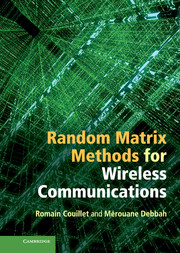Book contents
- Frontmatter
- Contents
- Preface
- Acknowledgments
- Acronyms
- Notation
- 1 Introduction
- Part I Theoretical aspects
- Part II Applications to wireless communications
- 11 Introduction to applications in telecommunications
- 12 System performance of CDMA technologies
- 13 Performance of multiple antenna systems
- 14 Rate performance in multiple access and broadcast channels
- 15 Performance of multi-cellular and relay networks
- 16 Detection
- 17 Estimation
- 18 System modeling
- 19 Perspectives
- 20 Conclusion
- References
- Index
20 - Conclusion
from Part II - Applications to wireless communications
Published online by Cambridge University Press: 07 October 2011
- Frontmatter
- Contents
- Preface
- Acknowledgments
- Acronyms
- Notation
- 1 Introduction
- Part I Theoretical aspects
- Part II Applications to wireless communications
- 11 Introduction to applications in telecommunications
- 12 System performance of CDMA technologies
- 13 Performance of multiple antenna systems
- 14 Rate performance in multiple access and broadcast channels
- 15 Performance of multi-cellular and relay networks
- 16 Detection
- 17 Estimation
- 18 System modeling
- 19 Perspectives
- 20 Conclusion
- References
- Index
Summary
Throughout this book, we tried to propose an up-to-date vision of the fundamental applications of random matrix theory to wireless communications. “Up-to-date” refers to the time when these lines were written. At the pace which the random matrix field evolves these days, the current book will be largely outdated when published. This is one of the two fundamental reasons why we thoroughly introduced the methods used to derive most of the results known to this day, as these technical approaches will take more time to be replaced by more powerful tools. The other, more important, reason why such an emphasis was made on these techniques, is that the wireless communication community is moving fast and is in perpetual need for new random matrix models for which mathematical research has no answer yet. Quite often, such an answer does not exist because it is either of no apparent interest to mathematicians or simply because too many of these problems are listed that cannot all be solved in a reasonable amount of time. But very often also, these problems can be directly addressed by non-mathematical experts. We desired this book to be both accessible in the sense that fast solutions to classical problems can be derived by wireless communication engineers and rigorous in some of the proofs so that precise proof techniques be known to whomever desires to derive mathematically sound information-theoretic results.
- Type
- Chapter
- Information
- Random Matrix Methods for Wireless Communications , pp. 511 - 514Publisher: Cambridge University PressPrint publication year: 2011



